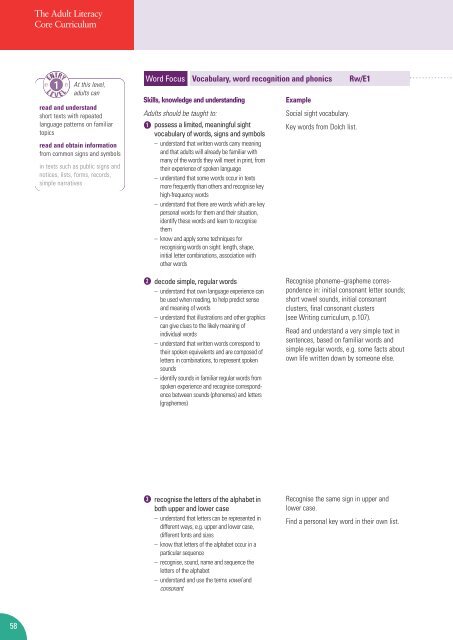Adult Literacy Core Curriculum - Nationally developed Skills for Life ...
Adult Literacy Core Curriculum - Nationally developed Skills for Life ...
Adult Literacy Core Curriculum - Nationally developed Skills for Life ...
You also want an ePaper? Increase the reach of your titles
YUMPU automatically turns print PDFs into web optimized ePapers that Google loves.
58<br />
The <strong>Adult</strong> <strong>Literacy</strong><br />
<strong>Core</strong> <strong>Curriculum</strong><br />
At this level,<br />
adults can<br />
read and understand<br />
short texts with repeated<br />
language patterns on familiar<br />
topics<br />
read and obtain in<strong>for</strong>mation<br />
from common signs and symbols<br />
in texts such as public signs and<br />
notices, lists, <strong>for</strong>ms, records,<br />
simple narratives<br />
Word Focus Vocabulary, word recognition and phonics Rw/E1<br />
<strong>Skills</strong>, knowledge and understanding<br />
<strong>Adult</strong>s should be taught to:<br />
1 possess a limited, meaningful sight<br />
vocabulary of words, signs and symbols<br />
– understand that written words carry meaning<br />
and that adults will already be familiar with<br />
many of the words they will meet in print, from<br />
their experience of spoken language<br />
– understand that some words occur in texts<br />
more frequently than others and recognise key<br />
high-frequency words<br />
– understand that there are words which are key<br />
personal words <strong>for</strong> them and their situation,<br />
identify these words and learn to recognise<br />
them<br />
– know and apply some techniques <strong>for</strong><br />
recognising words on sight: length, shape,<br />
initial letter combinations, association with<br />
other words<br />
2<br />
3<br />
decode simple, regular words<br />
– understand that own language experience can<br />
be used when reading, to help predict sense<br />
and meaning of words<br />
– understand that illustrations and other graphics<br />
can give clues to the likely meaning of<br />
individual words<br />
– understand that written words correspond to<br />
their spoken equivalents and are composed of<br />
letters in combinations, to represent spoken<br />
sounds<br />
– identify sounds in familiar regular words from<br />
spoken experience and recognise correspondence<br />
between sounds (phonemes) and letters<br />
(graphemes)<br />
recognise the letters of the alphabet in<br />
both upper and lower case<br />
– understand that letters can be represented in<br />
different ways, e.g. upper and lower case,<br />
different fonts and sizes<br />
– know that letters of the alphabet occur in a<br />
particular sequence<br />
– recognise, sound, name and sequence the<br />
letters of the alphabet<br />
– understand and use the terms vowel and<br />
consonant<br />
Example<br />
Social sight vocabulary.<br />
Key words from Dolch list.<br />
Recognise phoneme–grapheme correspondence<br />
in: initial consonant letter sounds;<br />
short vowel sounds, initial consonant<br />
clusters, final consonant clusters<br />
(see Writing curriculum, p.107).<br />
Read and understand a very simple text in<br />
sentences, based on familiar words and<br />
simple regular words, e.g. some facts about<br />
own life written down by someone else.<br />
Recognise the same sign in upper and<br />
lower case.<br />
Find a personal key word in their own list.

















